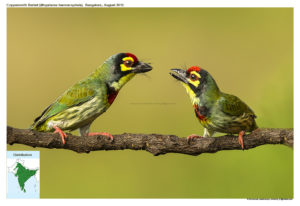Coppersmith Barbet

Coppersmith Barbet Megalaima haemacephala
Etymology:
- Megalaima: Greek word megalos- great; laimos- throat. { Great Throat}
- Haemacephala: Greek word haima blood; kephalos –headed { Red Headed}
Vernacular Name: Hindi: Kaathphora, Tambayat, Basanta lisora, Chhota basant, Thathera basant Pun: Chhota basanta, Bi: Phouk basanth, Ben: Chhota basanta bauri, Bhagirath, Ass: Basanta sorai, Hetuluka, Guj: Tuktukiyo, Kansaro, Mar: Juktuk, Sonar, Tambat, Pukpuk, Ta: Chinna kukuruvan, Te: Tokoji, Kamsali pitta, Mal: Chempukotti, Kan: Gutra, Sinh: Mal kottoruwa
They are tree dwelling fruit eating birds. They get their name from the bristles which fringe their heavy bills. They are also known as Crimson- breasted Barbet.
Distribution in India: Resident all over India.
Description: Size of 15–17 cm; wt. of 30–52·6 g. It is a small, chunky, green Barbet with streaked underparts, and reddish legs and orbital skin. The male of nominate race with red forehead and forecrown, yellow above and below eye, black eyestripe and moustache, all bordered at rear by black band, with some greyish-blue behind that. The chin and throat is yellow, red patch on lower throat and upper breast. The female is less bright red, has yellow in narrower red breast mark. The immature lacks all red at first, is streaky onto throat, has much paler bill.
Habitat: It is found in edges of moist forest, drier deciduous forest, scrub and secondary forest, plantations of diverse trees, mangroves, casuarina, gardens and fruit trees in villages and even cities, extending into wet forest clearings and areas around logging camps. It is found from sea-level to 2000 m.
Food Habits: It eats figs and other fruits, and berries, also flowers of. During nesting period they are also eat Insects and worms. It feeds at all levels; hawks for flying termites and moths, and works over bark of trees for insects. They are usually found in groups in fruit laden trees along with other frugivorous birds like Green pigeons, Bulbuls etc.
Breeding Habits: They breed in Jan–Oct in Pakistan, India and Nepal , generally Feb–Jul in Himalayan region; Nov–May in SriLanka; Feb–Jul in SE Asia and Philippines; Apr–Oct in Sumatra and Java . They are double brooded. Courtship involves singing, puffing of the throat, bobbing of the head, flicking of the tail, ritual feeding and allopreening. Both sexes excavate the nest on the underside of a narrow horizontal branch. They may also roost inside the nest holes. They lay a clutch of 3-4 eggs are laid .The incubation is done by both parents. The incubation period is 12-14 days. Both sexes incubate. Often two broods are raised in quick succession. The nestlings fed by both parents and parents perform activities like brooding, fecal sacs removal from nest area. The nestling period is 35 days.